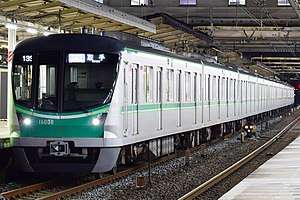Tokyo Metro 02 series
The Tokyo Metro 02 series (東京メトロ02系, Tōkyō Metoro 02-kei) is an electric multiple unit (EMU) train type operated since 1988 by Tokyo Metro on the Tokyo Metro Marunouchi Line subway in Tokyo, Japan. Its design is based on the Tokyo Metro 01 series.
| Tokyo Metro 02 series | |
|---|---|
 Marunouchi Line 02 series train at Yotsuya Station in June 2007 | |
| Manufacturer | Kawasaki Heavy Industries, Kinki Sharyo, Nippon Sharyo and Tokyu Car Corporation |
| Replaced | TRTA 300/400/500/900 series |
| Constructed | 1988–1996 |
| Entered service | October 1988 |
| Refurbished | 2010– |
| Number built | 336 vehicles (59 sets) |
| Number preserved | 2 vehicles (1 set, for overseas use as training vehicle in FEATI University, Manila, Philippines)[1] |
| Successor | Tokyo Metro 2000 series |
| Formation | 3/6 cars per trainset |
| Fleet numbers | 01-53 (6-car sets) 81-86 (3-car sets) |
| Capacity | 124 (42 seating) (end cars), 135/136 (50/52 seating) (intermediate cars) |
| Operator(s) | Tokyo Metro, previously TRTA |
| Depot(s) | Koishikawa, Nakano |
| Line(s) served | M Tokyo Metro Marunouchi Line |
| Specifications | |
| Car body construction | Aluminium |
| Car length | 18,000 mm (59 ft 1 in) |
| Width | 2,830 mm (9 ft 3 in) |
| Height | 3,495 mm (11 ft 5.6 in) |
| Doors | 3 per car |
| Maximum speed | 75 km/h (45 mph) |
| Traction system | Chopper control (1st-5th batch) IGBT-VVVF (5th-8th batch) |
| Power output | 120 kW |
| Transmission | Westinghouse-Natal (WN) drive; Gear ratio: 6.73 : 1 |
| Acceleration | 3.0 km/h/s (1st-5th batch) 3.2 km/h/s (5th-8th batch) |
| Deceleration | 4.0 km/h/s (5.0 km/h/s for emergency brake) |
| Electric system(s) | 600 V DC 3rd rail |
| Bogies | FS-520A, FS-020A (sets 01-19) SS-130, SS-030 (sets 20-53, 81-86) |
| Safety system(s) | CS-ATC (ATO), TASC Train stop(Obsolete) |
| Coupling system | Tomlinson |
| Track gauge | 1,435 mm (4 ft 8 1⁄2 in) |
Operations
A total of 336 cars were introduced into service from 17 October 1988 in 8 batches. 53 six-car trainsets (batches 1 to 7) operate on the main section of the Marunouchi Line, while the Hōnanchō branch uses six three-car 20-80 series trainsets (batch 8).
Formations
6-car sets
The 53 six-car sets (01-53) are formed as shown below, with car 6 at the Ikebukuro end.[2]
| Car No. | 1 | 2 | 3 | 4 | 5 | 6 |
|---|---|---|---|---|---|---|
| Designation | CT1 | M | T | M' | M | CT2 |
| Numbering | 02-100 | 02-200 | 02-300 | 02-400 | 02-500 | 02-600 |
3-car sets

The 6 three-car Hōnanchō branch line sets (81-86) are formed as shown below, with car 3 at the Nakano-Sakaue end.[2]
| Car No. | 1 | 2 | 3 |
|---|---|---|---|
| Designation | CM | M1 | CT' |
| Numbering | 02-180 | 02-280 | 02-380 |
Interior
 Interior (unrefurbished)
Interior (unrefurbished) Priority seating (unrefurbished)
Priority seating (unrefurbished) Driver's cab
Driver's cab An emergency intercom beside the doors
An emergency intercom beside the doors Destination indicator above passenger door
Destination indicator above passenger door LED screen above passenger door
LED screen above passenger door Interior for Hōnanchō Branch Line 3-car sets
Interior for Hōnanchō Branch Line 3-car sets
All refurbished trains have a pink interior and some LCD passenger information screens above all doors.
History
The first trains entered service from 17 October 1988.
In March 1998, Automatic Train Control was introduced on the 02 series, which was supplemented with a Train Automatic Stopping Controller (TASC) system allowing them to stop automatically at stations since November 2002.
Refurbishment

The 02 series fleet is undergoing major refurbishment, with the first treated trains returning to service from February 2010. Refurbishment includes the use of new Toshiba PMSM (permanent magnet synchronous motors), as fitted to the new Chiyoda Line 16000 series trains, offering energy savings of approximately 10%.[3] Internally, pairs of 17-inch LCD passenger information monitors are installed above the passenger doors. The interior is finished in a pale salmon pink colour reminiscent of the original 300 series trains used on the line, and externally, a white "sine wave" design has been added to the red bodyside stripes, again reminiscent of the 300 series livery.[4]
Replacement
A fleet of 53 new six-car trains is scheduled to be introduced from fiscal 2018, replacing the 02 series trains by fiscal 2022.[5] The new trains are classified as Tokyo Metro 2000 series.
References
- Shaw, Dennis and Morioka, Hisashi, "Tokyo Subways", published 1992 by Hoikusha Publishing
- 02 series on Marunouchi Line (Main), Tokyo Metro, retrieved 22 May 2007 (in Japanese)
- "東京メトロ、02系をフィリピンの大学に無償譲渡". Tetsudo.com. 21 January 2020.
- 私鉄車両編成表 私鉄車両編成表 2011 [Private Railway Rolling Stock Formations - 2011]. Japan: JRR. July 2011. p. 71. ISBN 978-4-330-22711-5.
- Shikata, K; et al. (16 October 2012). PMSM propulsion system for Tokyo Metro. Electrical Systems for Aircraft, Railway and Ship Propulsion (ESARS). pp. 1–6. doi:10.1109/ESARS.2012.6387456. ISBN 978-1-4673-1372-8.
- Tokyo Metro press release: "丸ノ内線車両に懐かしのサインウェーブが復活いたします" (14 January 2010). Retrieved 15 January 2010. (in Japanese)
- 大手民鉄 2016年度の車両の新造・更新予定 [Major private railway fiscal 2016 rolling stock construction and refurbishment plans]. Tetsudo Daiya Joho Magazine (in Japanese). Vol. 45 no. 389. Japan: Kotsu Shimbun. September 2016. p. 70.
External links
| Wikimedia Commons has media related to Tokyo Metro 02 series. |
- Tokyo Metro Marunouchi Line 02 series information (in Japanese)
- Tokyo Metro Marunouchi Branch Line 02 series information (in Japanese)
